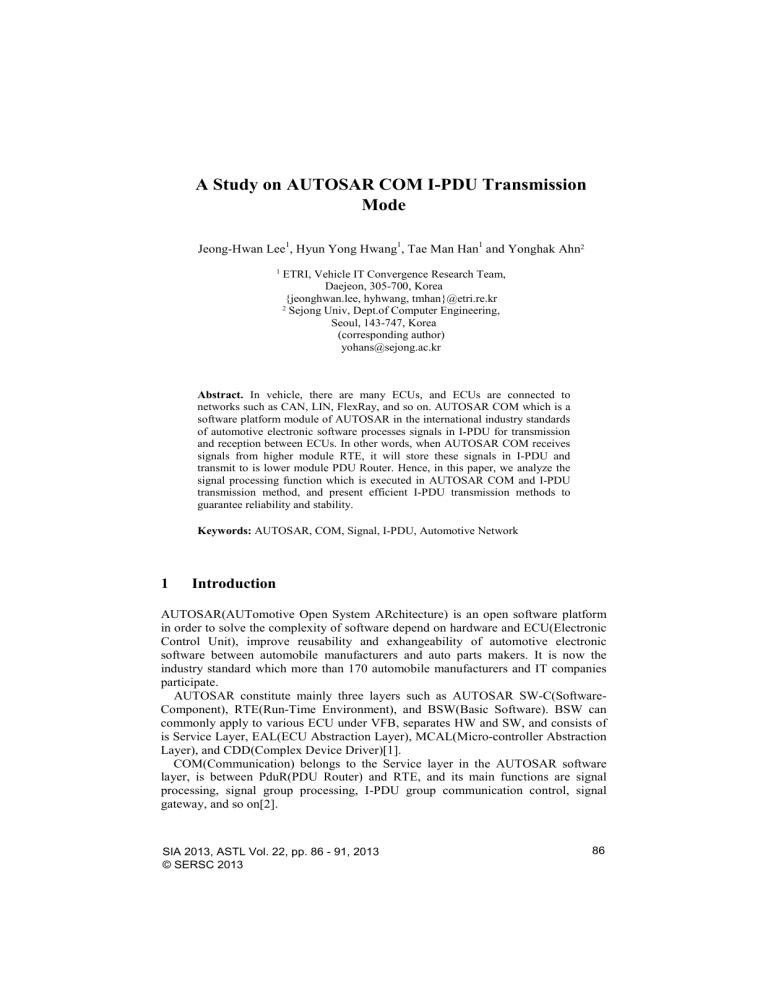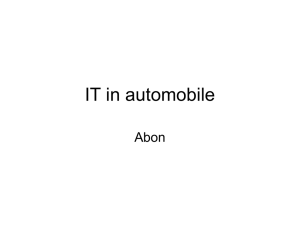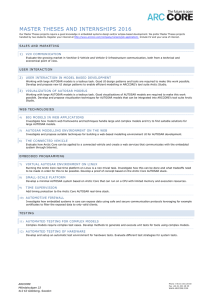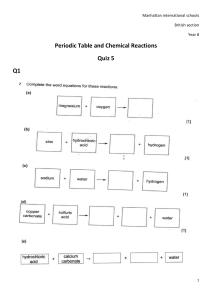
A Study on AUTOSAR COM I-PDU Transmission
Mode
Jeong-Hwan Lee1, Hyun Yong Hwang1, Tae Man Han1 and Yonghak Ahn2
1
ETRI, Vehicle IT Convergence Research Team,
Daejeon, 305-700, Korea
{jeonghwan.lee, hyhwang, tmhan}@etri.re.kr
2
Sejong Univ, Dept.of Computer Engineering,
Seoul, 143-747, Korea
(corresponding author)
yohans@sejong.ac.kr
Abstract. In vehicle, there are many ECUs, and ECUs are connected to
networks such as CAN, LIN, FlexRay, and so on. AUTOSAR COM which is a
software platform module of AUTOSAR in the international industry standards
of automotive electronic software processes signals in I-PDU for transmission
and reception between ECUs. In other words, when AUTOSAR COM receives
signals from higher module RTE, it will store these signals in I-PDU and
transmit to is lower module PDU Router. Hence, in this paper, we analyze the
signal processing function which is executed in AUTOSAR COM and I-PDU
transmission method, and present efficient I-PDU transmission methods to
guarantee reliability and stability.
Keywords: AUTOSAR, COM, Signal, I-PDU, Automotive Network
1
Introduction
AUTOSAR(AUTomotive Open System ARchitecture) is an open software platform
in order to solve the complexity of software depend on hardware and ECU(Electronic
Control Unit), improve reusability and exhangeability of automotive electronic
software between automobile manufacturers and auto parts makers. It is now the
industry standard which more than 170 automobile manufacturers and IT companies
participate.
AUTOSAR constitute mainly three layers such as AUTOSAR SW-C(SoftwareComponent), RTE(Run-Time Environment), and BSW(Basic Software). BSW can
commonly apply to various ECU under VFB, separates HW and SW, and consists of
is Service Layer, EAL(ECU Abstraction Layer), MCAL(Micro-controller Abstraction
Layer), and CDD(Complex Device Driver)[1].
COM(Communication) belongs to the Service layer in the AUTOSAR software
layer, is between PduR(PDU Router) and RTE, and its main functions are signal
processing, signal group processing, I-PDU group communication control, signal
gateway, and so on[2].
SIA 2013, ASTL Vol. 22, pp. 86 - 91, 2013
© SERSC 2013
86
Proceedings, The 2nd International Conference on Sensor and Its Applications
Accordingly, in this paper, we analyze the signal processing function which is
executed in AUTOSAR COM and I-PDU transmission method, and present efficient
I-PDU transmission methods to guarantee reliability and stability.
2
COM Signal
When higher module RTE sends signals using Com_SendSignal, COM stores signals
received from RTE in I-PDU buffer and it sends stored I-PDU using
PduR_ComTransmit function which is provided by lower module PDU Router[3],[4].
If PDU Router informs COM of reception of PDU using COM_RxIndication function
which is provided by COM, COM analyzes information of signals in PDU and tells
RTE reception of signals using RTE callback functions which are assigned
respectively to signals. RTE receives signals in COM using Com_ReceiveSignal
according to signals[3].
Fig. 1. Simplified model for Signal Transmission and Reception in COM.
3
COM I-PDU Transmission Mode
In this section, we look around operation principles of three methods such as
DIRECT/N-Times, PERIODIC, MIXED which are used when I-PDU transmission in
COM.
Table 1.
Transmission mode defined for I-PDU.
Transmission Mode
DIRECT/N-Times
PERIODIC
MIXED
Description
The transfer of the signal to AUTOSAR COM is immediately followed by
n transmissions (n = 1 … m, m <= 255) on the underlying layer
In Periodic transmission mode, AUTOSAR COM issues periodic transmission requests for an I-PDU to the underlying layer.
Mixed transmission mode is a combination of the “Direct/N-Times” and
the Periodic transmission modes.
87
A Study on AUTOSAR COM I-PDU Transmission Mode
Table 2.
Use case diagram legend.
Tc
Td
Tr,min
dT
3.1
Periodic Cycle times
Cycle times of Direct N-Times
Minimum SW reaction time of COM-Layer
Request from upper layers (RTE) to the COM-Layer
Request from COM-Layer to lower layers
Minimum distance between two requests to lower layers (minimum delay time), dT
can be set per I-PDU.
Direct/N-Times
When signals received from RTE are stored in I-PDU, DIRECT/N-Times method
immediately sends signals as many as the number of transmission set to the lower
modules. If it is used, it is a merit that upper modules can send current signals in IPDU at desired time. Following use case is an example that COM sends three I-PDUs
at once when signals received from RTE.
Fig. 2. Use case, Direct/N-Times = 3.
3.2
Periodic
PERIODIC method stores signals received from upper module RTE in I-PDU buffer,
and sends them to the lower modules periodically. If it is used, it is possible to send IPDU periodically. Following use case is an example to send I-PDU in periodic
intervals.
Fig. 3. Use case, Periodic.
3.3
Mixed
MIXED method is a mixed method which combines DIRECT/N-Times and
PERIODIC. It stores signals received from upper module RTE in I-PDU buffer, and
88
Proceedings, The 2nd International Conference on Sensor and Its Applications
send I-PDU as many as the number of transmission set to the lower modules
immediately and according to a period set. If it is used, it is possible to send I-PDU of
current signal values at desired time and periodically. Following use case is an
example to send three I-PDUs at once when receiving signals and periodically.
Fig. 4. Use case, Periodic + Direct/N-Times = 3.
4
4.1
Implementation and Test Results
Test Environment
We use C-language to implement, Altium's Tasking VX-toolset for C166 as complier,
Vector's CANoe as simulator, and Lauterbach' TRACE-32 as debugging device, and
program image results are loaded the target board built in Infineon XC2365A MCU.
Fig. 5. Test Environment screen.
89
A Study on AUTOSAR COM I-PDU Transmission Mode
4.1
Direct/N-Times
Fig. 6. Direct/N-Times Configuration and Test Result screen.
We set three transmission number as test environment set like the use case in Figure 2
and tested. The number of I-PDU messages per a second is 25 frames and the bus load
on the network is about 0.33%.
4.2
Periodic
Fig. 7. Periodic Configuration and Test Result screen.
We set the transmission period of Periodic method as 200ms and tested. The number
of I-PDU messages per a second is 5 frames and the bus load on the network is about
0.06%.
90
Proceedings, The 2nd International Conference on Sensor and Its Applications
4.3
Mixed
Fig. 8. Mixed Configuration and Test Result screen.
We set the number of transmission of Mixed method as three like Direct/N-Times and
the transmission period of Mixed method as 200ms like Periodic method and tested.
The number of I-PDU messages per a second is 106 frames and the bus load on the
network is about 1.39%.
5
Conclusion
As the test results in this paper, bus loads increases in Periodic, Direct/N-Times,
Mixed order but stability of data, reliability, and real-time increase in Periodic,
Direct/N-Times, Mixed order. Hence, transmission method of network should be
determined by considering application operations and data size when design of
network.
Acknowledgments. This work was supported by the Industrial Strategic Technology
Development Program funded by the Ministry of Knowledge Economy (MKE,
Korea) [10038724, Commercialization of AUTOSAR SW platform and development
tools].
References
1.
2.
3.
4.
AUTOSAR Home Page, http://www.autosar.org
AUTOSAR , Dec. 2008, AUTOSAR Layered Software Architecture
AUTOSAR, 2010, Specification of Communication V3.2.0 R3.1 Rev 5
AUTOSAR, 2010, Specification of PDU Router V3.2.0 R3.1 Rev 5
91





